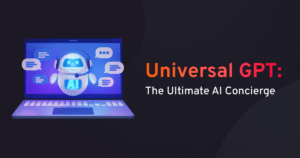In an age where digital interactions have become the norm, virtual assistants have begun to play an increasingly crucial role in our daily lives. These sophisticated and conversational AI systems are already reshaping how users interact with enterprises across numerous domains such as legal, finance, IT, HR, and supply chain management.
However, typical implementations that rely on a generic Large Language Model (LLM) often fall short when faced with in-depth, domain-specific queries. This is where a more integrated approach, utilizing a Universal GPT (Generative Pre-Trained Transformer), can thrive.
Universal GPT: A Truly Evolutionary Architecture
The allure of the Universal GPT framework, along with its modularly constructed underpinnings, lies in its remarkable flexibility to grow and adjust in line with the dynamic needs of enterprises. It is deliberately designed to accommodate the dynamicity of market demands, technological advances, and the expanding horizons of enterprise functionalities.
To draw a parallel with computer hardware, this architecture is reminiscent of a blade server system wherein individual blades (Expert VAs)—self-contained servers tailored to perform specific tasks—can be inserted or replaced within a blade center chassis (Host VA) that provides the necessary support infrastructure such as power and networking.
As the business evolves and the enterprise decides to expand into new domains or upgrade its existing ones, it can seamlessly integrate new domains into the Universal GPT architecture, akin to inserting additional blades into the existing blade server chassis.
These domain Expert VAs can be added/removed or updated independently, allowing for continuous refinement and enhancement of their knowledge and service quality without affecting the overall system’s stability or other domains. This is crucial, as it means adaptability is not a one-off event, but an ongoing capability built into the system’s design.
For enterprises, this translates to more than just convenience; it’s an investment in a solution that evolves alongside their own growth. It allows for an agile approach to deploying Generative AI support services—integrating new domain-specific VAs to cater to emerging needs or rapidly adjusting to shifts in the market.
From an operational standpoint, the Universal GPT architecture enables a unified user interface despite the expanding array of services. Users do not need to interact with an array of disjointed virtual assistants but can converse with a single, integrated interface that understands and adapts to the context of each inquiry. The Host VA remains the user’s central touchpoint, directing queries to the appropriate Expert VA behind the scenes, thereby maintaining coherence and simplicity in customer experience.

The Challenge of One Generic LLM for Multiple Domains
A generic large language model powering a monolithic AI virtual assistant system can be likened to a general practitioner in medicine. While it has broad knowledge, it lacks the deep, specialized understanding required to address complex concerns in highly specialized fields. Such an LLM may function adequately for general inquiries but strains to grasp and reproduce the nuanced terminology and expertise of each domain it serves.
For instance, if a user asks about compliance with employment law, the conversational AI platform as the virtual assistant must be able to interpret the current legal framework specific to the location of the user, ascertain whether the query relates to hiring practices, workplace safety, or discrimination policies, and provide guidance that is legally sound.
For instance, in the IT domain, users often seek assistance with highly technical and specific problems, such as troubleshooting software issues or configuring complex systems. A specialized AI IT support virtual assistant would need to be familiar with the intricacies of the software or hardware in question, able to guide users through diagnostic procedures, or even interpret error codes and logs to reach a resolution.
For instance, HR-related inquiries cover a gamut from onboarding processes to benefits administration to performance evaluations. An employee asking about their vacation balance is not just looking for numbers but might also want to know how leave can be scheduled around company holidays or whether unused vacation days can be carried over or converted into other benefits.
A Distributed Approach: Coordination Between Specialized Virtual Assistants
To ensure that users receive accurate and domain-specific responses to their inquiries, a new, innovative system is crucial. Picture this approach as unveiling the ultimate AI-powered concierge service: a primary Virtual Assistant (VA), let’s name it the “Host VA”, is the welcoming host, acting as the user’s first point of contact. The Host VA listens to the user’s request and instantly knows which expert to seek advice from for the answer, being the IT Expert VA, the HR Expert VA, the Legal Expert VA, the Finance Expert VA, etc.
Let’s take an example. John, a marketing director, turns to the company Host VA and asks, “How can our new overseas contract comply with local environmental regulations, and could you also fix the malfunctioning video conferencing system before my meeting at 3 PM today?”. The Host VA discerns the dual nature of John’s request. The compliance question, it deftly connects John to the Legal Expert VA, who possesses an intricate knowledge of international laws and can draft a compliance checklist.
Meanwhile, for the technical issue, it swiftly routes the task to the IT Expert VA, who can diagnose and resolve the video conferencing hiccup just in time for John’s meeting.
This setup parallels the “blade server” architecture familiar in the IT world: Think of the Host VA as the main blade center chassis, an ever-present foundation that holds various “blades”. These blades are domain-specialized VAs that can be slotted in and out as needed.
Each blade is meticulously trained using domain-specific datasets and further grounded using customer-specific knowledge for specific tasks—legal advice, tech support, or financial planning—ensuring that the user not only gets an answer but gets it from an expert designed for that purpose.
This illustrates the transformative potential of marrying the adaptability of the Host VA to a cohort of domain expert VAs—an AI concierge service that delivers an experience that is not just responsive but resonant with the expertise that users seek.
Functions of the Host and Domain-Expert Virtual Assistants.
The Host VA acts as the initial point of contact for users, discerning their needs and facilitating the conversation toward a resolution. It is tasked with Domain Identification and User-Request Routing, where it utilizes fine-tuned LLMs like Aisera’s enterprise LLM enabling it to understand the specific domain of each user request—whether it’s in IT, HR, Legal, and so forth—and channel the inquiry to the corresponding domain Expert VA. This method ensures that users interact with a virtual assistant that speaks their domain language fluently.
Moreover, the Host VA is entrusted with handling Small Talks / Dangerous Talks / Profanity Talks / etc., adding a layer of user engagement that maintains the conversation’s flow in a natural and coherent manner. This element of user interaction plays a significant role in enhancing the user’s overall experience, mirroring human-like interactions.
Additionally, the Host VA proves its versatility by performing Single and Multiple Intent-Extraction, which involves parsing the user dialogue, understanding complex statements that may carry more than one intent, and cleanly allocating the dialogue’s segments to the respective domain Expert VA for further processing.
On the other hand, the domain Expert VAs are the specialized force that tackles intricate, domain-enclosed conversations through robust Context Management. Each Expert VA predicts and maintains the thread of context within its specialized field, preventing any bleed-over of context from unrelated domains, which might otherwise lead to confusion and less accurate responses.
When it comes to User Request Disambiguation, these specialized VAs are the experts. Since they possess a profound understanding of their respective domains, they are equipped to unravel ambiguous requests, ask focused clarifying questions, and carefully guide the user through a series of interactions that edge towards a satisfying resolution. This ability stands as a hallmark of their in-depth expertise and is critical for ensuring accurate and helpful responses to user inquiries.
Together, the Host and domain Expert VAs orchestrate a seamless conversational flow, catering to the nuances of user requests across various sectors with precision and eloquence.
Conclusions
The deployment of Universal GPTs within a dynamic, domain-specific LLM architecture heralds a significant advancement for virtual assistants. This distributed approach combines the broad-reach capabilities of a General LLM with the deep-domain expertise of specialized models to address multi-faceted user queries accurately and effectively.
As virtual assistants continue to emerge as integral components of business operations and customer service strategies, the universal application of GPTs serving many domains stands as a beacon, illuminating the path toward more intelligent, responsive, and personalized user experiences.
The convergence of generative AI technology and modular domain-specific expertise will redefine how enterprises engage with their users while operating a virtual assistant infrastructure capable of evolving in tandem with their future growth and needs. Book a custom AI demo and explore Aisera’s Universal Bot for your enterprise today!

